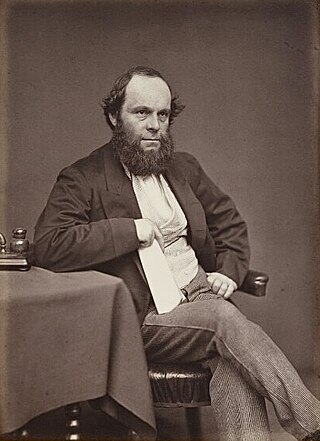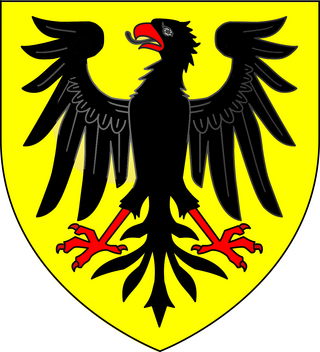Duke of Buckingham, referring to Buckingham, is an extinct title that has been created several times in the peerages of England, Great Britain, and the United Kingdom. There were creations of double dukedoms of Buckingham and Normanby and of Buckingham and Chandos. The last holder of the dukedom died in 1889.

Richard Temple, 1st Viscount Cobham was a British soldier and Whig politician. After serving as a junior officer under William III during the Williamite War in Ireland and during the Nine Years' War, he fought under John Churchill, 1st Duke of Marlborough, during the War of the Spanish Succession. During the War of the Quadruple Alliance Temple led a force of 4,000 troops on a raid on the Spanish coastline which captured Vigo and occupied it for ten days before withdrawing. In Parliament he generally supported the Whigs but fell out with Sir Robert Walpole in 1733. He was known for his ownership of and modifications to the estate at Stowe and for serving as a political mentor to the young William Pitt.

Baron Lyttelton is a title that has been created once in Peerage of England and twice in Peerage of Great Britain, both times for members of the Lyttelton family. Since 1889 the title has been a subsidiary title of the viscountcy of Cobham.

Viscount Cobham is a title in the Peerage of Great Britain that was created in 1718. Owing to its special remainder, the title has passed through several families. Since 1889, it has been held by members of the Lyttelton family.

Earl of Kingston is a title in the Peerage of Ireland. It was created in 1768 for Edward King, 1st Viscount Kingston. The Earl holds the subsidiary titles Baron Kingston, of Rockingham in the County of Roscommon, Viscount Kingston, of Kingsborough in the County of Sligo, Baron Erris, of Boyle in the County of Roscommon, and Viscount Lorton, of Boyle in the County of Roscommon, also in the Peerage of Ireland. He is also a baronet in the Baronetage of Ireland. Between 1821 and 1869 the earls also held the title Baron Kingston, of Mitchelstown in the County of Cork, in the Peerage of the United Kingdom.

Earl of Drogheda is a title in the Peerage of Ireland. It was created in 1661 for The 3rd Viscount Moore.

Earl Temple of Stowe, in the County of Buckingham, is a title in the Peerage of the United Kingdom. It was created in 1822 for Richard Temple-Nugent-Brydges-Chandos-Grenville, 2nd Marquess of Buckingham, who was created Marquess of Chandos and Duke of Buckingham and Chandos at the same time. In contrast to the Marquessate and Dukedom, which were created with remainder to the heirs male of his body only, the Earldom was created with remainder to (1) the heirs male of his body, failing which to (2) the heirs male of his deceased great-grandmother the 1st Countess Temple, failing which to (3) his granddaughter Lady Anna Grenville and the heirs male of her body, and then to possible younger daughters of Lord Temple and the heirs male of their bodies.
The Baronetcy of Temple, of Stowe, in the Baronetage of England, was created on the 24th of September 1611 for Thomas Temple, eldest son of John Temple of Stowe, Buckinghamshire. His great-grandson Sir Richard, 4th Baronet, was created Baron Cobham on 19 October 1714, and Viscount Cobham and Baron Cobham on 23 May 1718, the latter with a special remainder, failing his male issue to his sisters and their heirs male. Upon his death on the 13th September 1749, the barony of 1714 became extinct. Both the viscountcy and barony of 1718 passed to his elder sister, and the baronetcy passed to his second cousin once removed William Temple, of Nash House, who became 5th Baronet. On the death of Sir William's nephew Sir Richard Temple, 7th Baronet, on 15 November 1786, the baronetcy became dormant.

William Francis Cowper-Temple, 1st Baron Mount Temple, PC, known as William Cowper before 1869 and as William Cowper-Temple between 1869 and 1880, was a British Liberal statesman.

Earl Cowper was a title in the Peerage of Great Britain. It was created in 1718 by George I for William Cowper, 1st Baron Cowper, his first Lord Chancellor, with remainder in default of male issue of his own to his younger brother, Spencer Cowper. Cowper had already been created Baron Cowper of Wingham in the County of Kent, in the Peerage of England on 14 December 1706, with normal remainder to the heirs male of his body, and was made Viscount Fordwich, in the County of Kent, at the same time as he was given the earldom, also Peerage of Great Britain and with similar remainder. He was the great-grandson of William Cowper, who was created a Baronet, of Ratling Court in the County of Kent, in the Baronetage of England on 4 March 1642. The latter was succeeded by his grandson, the second Baronet. He represented Hertford in Parliament. He was succeeded by his eldest son, the aforementioned William Cowper, the third Baronet, who was elevated to the peerage as Baron Cowper in 1706 and made Earl Cowper in 1718. In 1706 Lord Cowper married as his second wife Mary Clavering, daughter of John Clavering, of Chopwell, County Durham.

Richard Plantagenet Campbell Temple-Nugent-Brydges-Chandos-Grenville, 3rd Duke of Buckingham and Chandos,, styled Earl Temple until 1839 and Marquess of Chandos from 1839 to 1861, was a British soldier, politician and administrator of the 19th century. He was a close friend and subordinate of Benjamin Disraeli and served as the secretary of state for the colonies from 1867 to 1868 and governor of Madras from 1875 to 1880.

Broadlands is a country house located in the civil parish of Romsey Extra, near the town of Romsey in the Test Valley district of Hampshire, England. Its formal gardens and historic landscape are Grade II* listed on the Register of Historic Parks and Gardens. The house itself is Grade I listed.

Earl Nugent was a title the Peerage of Ireland. It was created on 21 July 1776 for Robert Craggs-Nugent, 1st Viscount Clare, with remainder, failing heirs male of his body, to his son-in-law The 3rd Earl Temple and the heirs male of his body. Craggs-Nugent had already been made Baron Nugent, of Carlanstown in the County of Westmeath, and Viscount Clare, in the Peerage of Ireland on 19 January 1767. He died 13 October 1788, when the barony and viscountcy became extinct, and the earldom, under the terms of the special remainder, passed to his son-in-law, formerly known as Lord Temple, now The 1st Marquess of Buckingham. The earldom remained in his family until the death of The 5th Earl Nugent, also The 3rd Duke of Buckingham and Chandos, on 26 March 1889. See Viscount Cobham for further history of the title. The barony of Nugent was revived in 1800 in favour of his daughter, Mary, Marchioness of Buckingham. See Baron Nugent.

Baron Mount Temple was a title that was created twice in British history, both times in the Peerage of the United Kingdom. The first creation came on 25 May 1880 when the Liberal politician the Honourable William Cowper-Temple was made Baron Mount Temple, of Mount Temple in the County of Sligo. He was born William Cowper, the second son of Peter Clavering-Cowper, 5th Earl Cowper by his wife the Honourable Emily, sister of the 2nd Viscount Melbourne. Emily married as her second husband the 3rd Viscount Palmerston, a man who would serve as British prime minister. Lord Palmerston, an Anglo-Irish peer, died in 1865 when the viscountcy and his junior title of Baron Temple, of Mount Temple, became extinct. Emily died 11 September 1869, leaving her second husband's estates, including Broadlands in Hampshire, to her second son, William, who thereupon adopted by royal licence the surname Cowper-Temple, in whose favour the Mount Temple title was revived in 1880. William was married to Georgina Tollemache.

Stowe House is a grade I listed country house in Stowe, Buckinghamshire, England. It is the home of the private Stowe School and is owned by the Stowe House Preservation Trust. Over the years, it has been restored and maintained as one of the finest country houses in the UK. Stowe House is regularly open to the public.
Henry Temple, 2nd Viscount Palmerston, FRS, was a British politician.

Frances Elizabeth Jocelyn, Viscountess Jocelyn, VA was a British courtier and amateur photographer. She was born as the youngest daughter of Peter Cowper, 5th Earl Cowper and his wife Emily Lamb. However, some have speculated that she and her brother William were fathered by Henry John Temple, 3rd Viscount Palmerston, whom Lady Cowper married in 1839, after Cowper's death. Before her marriage, Lady Frances served as one of the trainbearers at the coronation of Queen Victoria, and she also served as a bridesmaid at the wedding of the queen to Prince Albert in 1840.
William Stephen Temple-Gore-Langton, 4th Earl Temple of Stowe, known as William Gore-Langton until 1892, was a British Conservative politician.

Sir Richard Temple, 3rd Baronet, KB was an English politician who sat in the House of Commons at various times between 1654 and 1697.

The Lyttelton family is a British aristocratic family. Over time, several members of the Lyttelton family were made knights, baronets and peers. Hereditary titles held by the Lyttelton family include the viscountcies of Cobham and Chandos, as well as the Lyttelton barony and Lyttelton baronetcy. Several other members of the family have also risen to prominence, particularly in the field of cricket.















